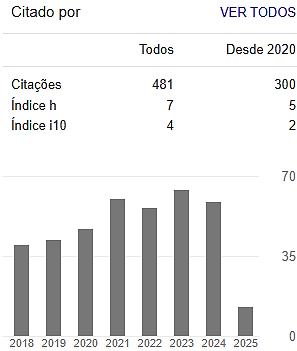EASY ASSISTANT: UMA FERRAMENTA DE AUXÍLIO PARA O DESENVOLVIMENTO DE CHATBOTS DE DOMÍNIO ESPECÍFICO
Palavras-chave:
Inteligência Artificial, Agentes Virtuais, Agentes InteligentesResumo
Sistemas inteligentes estão ligados principalmente ao ato de trazer cada vez mais suporte às pessoas. Atualmente nota-se o uso crescente de elementos relacionados à capacidade de aprendizado de máquinas, ou seja, Inteligência Artificial (IA). Em IA, destacam-se os chatbots, agentes personalizados e virtuais com certo nível emocional e cognitivo, normalmente presentes em sistemas colaborativos, sociais ou de aprendizagem, a fim de oferecer algum serviço com interação persistente e fortemente relacional aos usuários. Desenvolver tal agente não é trivial pois deve fornecer uma comunicação consistente e imersiva, aplicando várias técnicas complexas de processamento, compreensão e geração de linguagem natural, bem como, classificação de entidades, objetivos, auto-recuperação para evitar inconsistências de conversa e perda de contexto, dentre outros. Diante disso, este trabalho apresenta uma ferramenta web que permite ao usuário desenvolver, treinar e personalizar seu agente virtual de chatbot. Este agente faz uso de dois modelos de treinamento e obtenção de respostas baseado nos modelos de recuperação e generativo, construídos sob redes neurais que manipulam uma base de dados definida pelo usuário. A ferramenta foi testada e avaliada visando qualificar sua acurácia, a qual demonstrou atingir seus objetivos, bem como, permitir a criação de um chatbot personalizado.
Downloads
Referências
ABADI, Martın; BARHAM, Paul; CHEN, Jianmin; et al. TensorFlow: A system for large-scale machine learning. p. 21, .
BANKS, Alex; PORCELLO, Eve. Learning React: functional web development with React and Redux. " O'Reilly Media, Inc.", 2017.
BORDES, Antoine; BOUREAU, Y.-Lan; WESTON, Jason. Learning End-to-End Goal-Oriented Dialog. arXiv:1605.07683 [cs], 2017. Disponível em: <http://arxiv.org/abs/1605.0
>. Acesso em: 16 abr. 2020.
BORGES, Luiz Eduardo. Python para desenvolvedores: aborda Python 3.3. Novatec Editora, 2014.
CAHN, Jack. CHATBOT: Architecture, Design, & Development. p. 46, .
DHINGRA, Bhuwan; LI, Lihong; LI, Xiujun; et al. Towards End-to-End Reinforcement Learning of Dialogue Agents for Information Access. arXiv:1609.00777 [cs], 2017. Disponível em: <http://arxiv.org/abs/1609.00777>. Acesso em: 3 maio 2020.
GRAVES, Alex; MOHAMED, Abdel-rahman; HINTON, Geoffrey. Speech Recognition with Deep Recurrent Neural Networks. p. 5, .
GREFF, Klaus; SRIVASTAVA, Rupesh K.; KOUTNIK, Jan; et al. LSTM: A Search Space Odyssey. IEEE Transactions on Neural Networks and Learning Systems, v. 28, n. 10, p. 2222–2232, 2017.
GULLI, Antonio; PAL, Sujit. Deep learning with Keras. Packt Publishing Ltd, 2017.
HUNTER, John D. Matplotlib: A 2D graphics environment. IEEE Annals of the History of Computing, v. 9, n. 03, p. 90-95, 2007.
KALCHBRENNER, Nal; BLUNSOM, Phil. Recurrent Continuous Translation Models. p. 10, .
LIU, Bing; LANE, Ian. An End-to-End Trainable Neural Network Model with Belief Tracking for Task-Oriented Dialog. Interspeech 2017, p. 2506–2510, 2017.
LIU, Bing; TUR, Gokhan; HAKKANI-TUR, Dilek; et al. Dialogue Learning with Human Teaching and Feedback in End-to-End Trainable Task-Oriented Dialogue Systems. arXiv:1804.06512 [cs], 2018. Disponível em: <http://arxiv.org/abs/1804.06512>. Acesso em: 6 mar. 2020.
LOKMAN, Abbas Saliimi; AMEEDEEN, Mohamed Ariff. Modern Chatbot Systems: A Technical Review. In: ARAI, Kohei; BHATIA, Rahul; KAPOOR, Supriya (Orgs.). Proceedings of the Future Technologies Conference (FTC) 2018. Cham: Springer International Publishing, 2019, v. 881, p. 1012–1023. Disponível em: <http://link.springer.com/10.1007/978-3-030-02683-7_75>. Acesso em: 18 out. 2019.
LOPER, Edward; BIRD, Steven. Nltk: The natural language toolkit. arXiv preprint cs/0205028, 2002.
LUONG, Minh-Thang; PHAM, Hieu; MANNING, Christopher D. Effective Approaches to Attention-based Neural Machine Translation. p. 11, .
MIKOLOV, Tomas; KARAFIAT, Martin; BURGET, Lukas; et al. Recurrent Neural Network Based Language Model. p. 4, .
MINAEE, Shervin; KALCHBRENNER, Nal; CAMBRIA, Erik; et al. Deep Learning Based Text Classification: A Comprehensive Review. v. 1, n. 1, p. 43.
NADKARNI, Prakash M; OHNO-MACHADO, Lucila; CHAPMAN, Wendy W. Natural language processing: an introduction. J Am Med Inform Assoc, p. 8.
RUSSELL, Stuart J.; NORVIG, Peter. Artificial intelligence: a modern approach. Third edition, Global edition. Boston Columbus Indianapolis: Pearson, 2016. (Prentice Hall series in artificial intelligence).
SILVA, Maurício Samy. Construindo sites com CSS e (X) HTML: sites controlados por folhas de estilo em cascata. Novatec Editora, 2007.
SILVA, Mauricio Samy. HTML5: a linguagem de marcação que revolucionou a web. Novatec Editora, 2019.
SINGH, Abhishek; RAMASUBRAMANIAN, Karthik; SHIVAM, Shrey. Building an Enterprise Chatbot: Work with Protected Enterprise Data Using Open Source Frameworks. Berkeley, CA: Apress, 2019. Disponível em: <http://link.springer.com/10.1007/
-1-4842-5034-1>. Acesso em: 3 nov. 2019.
SONG, Yiping; LI, Cheng-Te; NIE, Jian-Yun; et al. An Ensemble of Retrieval-Based and Generation-Based Human-Computer Conversation Systems. In: Proceedings of the Twenty-Seventh International Joint Conference on Artificial Intelligence. Stockholm, Sweden: International Joint Conferences on Artificial Intelligence Organization, 2018, p. 4382-4388. Disponível em <https://www.ijcai.org/proceedings
/2018/609>. Acesso em: 10 ago. 2020.
SRINIVASA-DESIKAN, Bhargav. Natural Language Processing and Computational Linguistics: A practical guide to text analysis with Python, Gensim, spaCy, and Keras. Packt Publishing Ltd, 2018.
SUTSKEVER, Ilya; VINYALS, Oriol; LE, Quoc V. Sequence to Sequence Learning with Neural Networks. p. 9.
WEIZENBAUM, Joseph. ELIZA --- a computer program for the study of natural language communication between man and machine. Communications of the ACM, v. 26, n. 1, p. 23–28, 1983.
WEN, Tsung-Hsien; VANDYKE, David; MRKSIC, Nikola; et al. A Network-based End-to-End Trainable Task-oriented Dialogue System. arXiv:1604.04562 [cs, stat], 2017. Disponível em <http://arxiv.org/abs/1604.04562>. Acesso em: 19 maio 2020.
YANG, Liu; HU, Junjie; QIU, Minghui; et al. A Hybrid Retrieval-Generation Neural Conversation Model. arXiv:1904.09068 [cs], 2019. Disponível em: <http://arxiv.org/abs/1904.0
>. Acesso em: 10 ago. 2020.
ZHANG, Juzheng; THALMANN, Nadia Magnenat; ZHENG, Jianmin. Combining Memory and Emotion With Dialog on Social Companion: A Review. In: Proceedings of the 29th International Conference on Computer Animation and Social Agents - CASA ’16. Geneva, Switzerland: ACM Press, 2016, p. 1–9. Disponível em: <http://dl.acm.org/citation.cfm?do
id=2915926.2915952>. Acesso em: 11 fev. 2019.
ZHOU, Chunting; SUN, Chonglin; LIU, Zhiyuan; et al. A C-LSTM Neural Network for Text Classification. p. 10.
ZOPH, Barret; KNIGHT, Kevin. Multi-Source Neural Translation. arXiv:1601.00710 [cs], 2016. Disponível em: <http://arxiv.org/abs/1601.0
>. Acesso em: 21 out. 2020.

